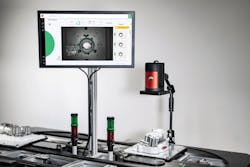AI Vision vs. Legacy Machine Vision: Why Manufacturers Are Making the Switch for Quality Control
Why this article is worth reading:
- Legacy systems are reaching their limits because traditional machine vision requires expensive hardware, specialized programming and struggles with product variations, environmental changes and agile manufacturing demands.
- Modern AI systems use standard hardware with plug-and-play interfaces and can be deployed in hours rather than weeks, often paying for themselves within months.
- When products change, AI models can be retrained in real-time with just a few dozen new images, eliminating dependency on costly consultants and lengthy reprogramming.
In industrial environments, legacy machine vision systems have long been the backbone of automated quality control (QC) and quality verification (QV) processes. These systems, which are generally rules-based and reliant on traditional image processing techniques, have been widely deployed to inspect products for defects, measure components and ensure compliance with design specifications.
However, these legacy vision technologies have several constraints that can impact current and developing manufacturing requirements.
For example, consider that exact calibration of cameras, lenses and lighting are typical requirements of legacy vision system technology. They also need intensive, detailed programming to do specific detection tasks. This means that many manufacturers will require outside consulting support to implement these complex systems.
And while being highly effective in controlled conditions, these legacy vision systems face limitations in dynamic manufacturing settings where businesses need process agility to react to changes in the supply chain or meet evolving customer demands.
One of the primary constraints of legacy vision system technology is the cost. These systems are typically composed of high-performance hardware, such as industrial-grade cameras, dedicated lighting setups and custom computing platforms. Integrating and calibrating these components requires specialized engineering expertise, which drives up capital and operational expenditures.
On top of this, any changes to the inspection parameters or additions of new product lines often involves significant reprogramming, increasing the time and cost of system updates.
Highly complex tasks involving precise metrology, subtle defect gradation or multi-layered assemblies may still require bespoke vision setups, advanced imaging — such as thermal, hyperspectral or 3D — or tightly engineered lighting and optics.
Environmental sensitivity is another major drawback. Legacy systems depend heavily on consistent lighting and camera placement. Even slight changes in illumination, such as variations in light color, shadows or glare — sometimes simply caused by aging bulbs — can compromise image quality and trigger false positives or missed defects.
Legacy vision systems also struggle to compensate for camera-related variances, like dust, lens distortion or sensor inconsistencies, which can affect measurement precision or flaw detection.
The impact of product variation on legacy vision tech
Because they are built on rules-based systems, legacy vision tech relies on predefined thresholds and rigid logic to determine pass/fail criteria. As a result, they often don’t accommodate natural variations in materials, orientation, texture or appearance that occur in real-world production. When a product changes, even slightly, the system may need to be reconfigured or reprogrammed from scratch, requiring extensive downtime and sometimes expensive consultants.
With mass customization and agile production becoming the norm across the manufacturing industries, these inflexible systems are reaching their limits. This is leading manufacturers to turn to AI-powered vision systems that offer greater adaptability, robustness to environmental conditions and scalability across product variants. To make the most of these AI-powered vision systems, understanding the constraints of legacy vision systems is essential to managing transition risks and identifying opportunities for modernization in industrial QC/QV.
Why AI vision systems are more cost-effective, agile and rapidly deployable
One of the most compelling advantages of AI vision platforms is their low cost of acquisition and setup. These systems often use off-the-shelf hardware — standard industrial or consumer-grade cameras paired with GPU-enabled edge devices or cloud-connected processors. Instead of requiring high-end optics, custom lighting or expensive PC-based control systems, AI models can compensate for variability in lighting and orientation, reducing the need for costly infrastructure.
Ease of deployment is another benefit to AI vision systems. Many commercial AI vision tools now come with wizard-based, plug-and-play interfaces. These intuitive platforms allow users with little or no programming background to set up an inspection task, define pass/fail criteria and begin model training within minutes. This means these systems can be set up in hours instead of days or weeks, dramatically reducing downtime during integration or product changeovers.
One of the primary constraints of legacy vision system technology is the cost. These systems are typically composed of high-performance hardware, such as industrial-grade cameras, dedicated lighting setups and custom computing platforms.
Most importantly, these AI systems are designed with agility and easy retraining in mind. When products evolve due to design tweaks, material changes or production variability, the AI models can be retrained on new datasets in real time. Often, this process requires nothing more than capturing a few dozen images and guiding the system through a brief retraining process. This removes the dependency on costly vision consultants or specialists, empowering in-house staff to maintain and adapt the system as needed.
Another significant benefit is the quick and measurable return on investment (ROI) associated with AI vision technology. By reducing false rejects, capturing previously undetectable defects and allowing faster product transitions, AI vision systems often pay for themselves within months. They also generate valuable data for continuous improvement and traceability, aligning well with Industry 4.0 and smart factory initiatives.
Limitations of low-cost AI vision systems
While AI vision systems perform exceptionally well for many manufacturing inspection tasks, such as surface defect detection, presence/absence checks or part orientation, they are not a universal solution. Highly complex tasks involving precise metrology, subtle defect gradation or multi-layered assemblies may still require bespoke vision setups, advanced imaging — such as thermal, hyperspectral or 3D — or tightly engineered lighting and optics.
AI vision systems can also struggle if the training data is insufficient or too narrow in scope, leading to false positives or missed defects. To avoid these issues with AI vision systems, manufacturers should approach them with a balanced view, recognizing that AI is a powerful, low-cost tool for many vision inspection needs, though not yet a total replacement in every use case.
Jim Wilmot, Product Manager, Simatic, Software and Motion Control at Siemens, will showcase Siemens’ Adaptive AI Vision Systems at SPS Atlanta in September. Jim, who has been with Siemens for more than 27 years, works with the company’s industrial automation products across the U.S. in all areas of industry.
More vision system coverage from Automation World:
About the Author
Jim Wilmot
Jim Wilmot is product manager of Simatic Software and Motion Control at Siemens. He has been with Siemens for more than 27 years and works with the company’s industrial automation products across the U.S. in all areas of industry.

Leaders relevant to this article:


